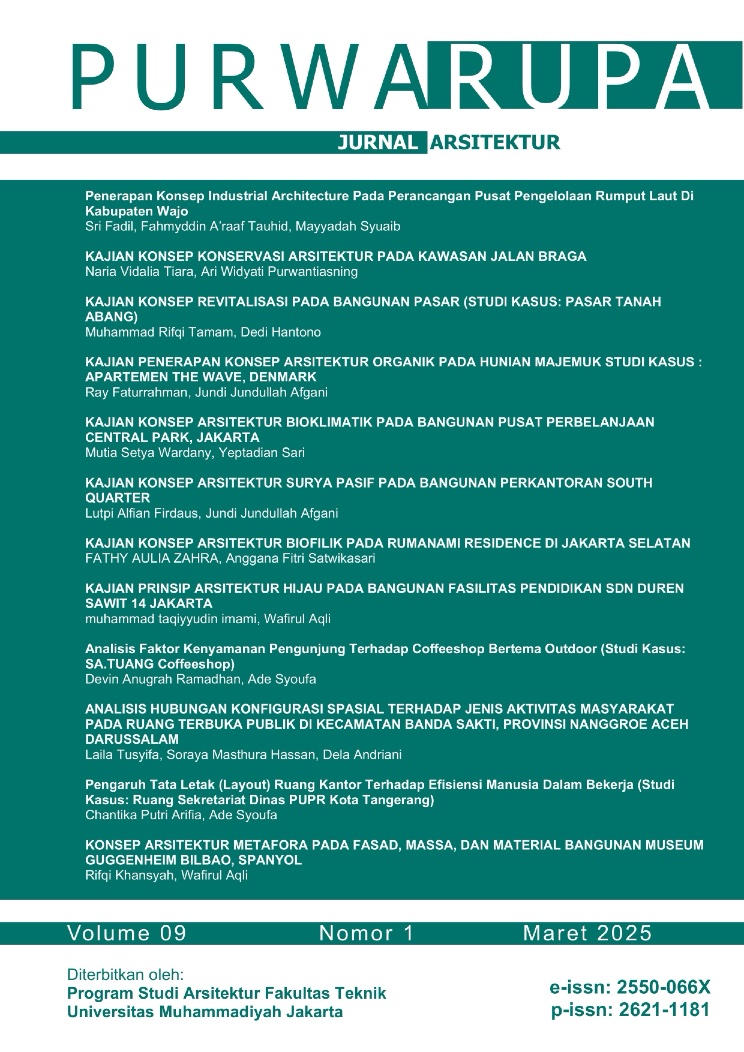KAJIAN KONSEP REVITALISASI PADA BANGUNAN PASAR (STUDI KASUS: PASAR TANAH ABANG)
Abstract
ABSTRAK. Pasar tradisional di Indonesia mengalami tantangan dalam pengembangannya, baik secara fisik maupun non fisik. Meskipun sebagian besar masyarakat Indonesia masih mengandalkan pasar tradisional untuk memenuhi kebutuhan sehari-hari, banyak pasar mengalami penurunan peran karena adanya kebutuhan yang meningkat. Pasar tradisional, menjadi salah satu tempat bagi masyarakat untuk mencari nafkah, berdagang dan menjual jasa, kini harus bersaing dengan perkembangan zaman yaitu belanja online dan toko swalayan. Revitalisasi pasar tradisional menjadi solusi untuk mengatasi tantangan tersebut. Revitalisasi diharapkan dapat meningkatkan daya saing pasar tradisional dengan cara memperbaiki kondisi fisik dan non fisik pasar, serta menyesuaikannya dengan perkembangan zaman. Bagaimana penerapan konsep revitalisasi pasar tradisional? Metode penelitian menggunakan metode kualitatif dan deskriptif,yaitu metode dengan menggunakan data yang ada serta landasan teori. Observasi lapangan dilakukan untuk mengkaji kondisi fisiki dan non fisik. Revitalisasi Pasar Tanah Abang telah berhasil dilakukan dengan melibatkan aspek fisik, ekonomi, sosial, dan institusional. Intervensi fisik berupa pembangunan jembatan penghubung antar blok telah meningkatkan konektivitas dan aksesibilitas pasar, serta memberikan tempat berjualan bagi pedagang. Rehabilitasi ekonomi melalui fungsi campuran jembatan sebagai tempat berdagang telah meningkatkan pendapatan pedagang dan daya tarik pasar. Berdasarkan penelitian ini, revitalisasi sosial/institusional melalui pengelolaan pasar oleh pengurus yang bertanggung jawab telah meningkatkan kualitas pelayanan dan keamanan pasar. Kata Kunci: Arsitektur, Revitalisasi, Pasar Tradisional ABSTRACT. Traditional markets in Indonesia experience challenges in their development, both physical and non-physical. Although the majority of Indonesian people still rely on traditional markets to meet their daily needs, many markets are experiencing a decline in their role due to increasing needs. Traditional markets, being a place for people to earn a living, trade and sell services, now have to compete with current developments, namely online shopping and supermarkets. Revitalizing traditional markets is a solution to overcome these challenges. Revitalization is expected to increase the competitiveness of traditional markets by improving the physical and non-physical conditions of the market, as well as adapting them to current developments. How is the concept of traditional market revitalization implemented? The research method uses qualitative and descriptive methods, namely methods using existing data and a theoretical basis. Field observations were carried out to assess physical and non-physical conditions. The revitalization of Tanah Abang Market has been successfully carried out involving physical, economic, social and institutional aspects. Physical intervention in the form of building connecting bridges between blocks has improved market connectivity and accessibility, as well as providing a place to sell for traders. Economic rehabilitation through the bridge's mixed function as a trading venue has increased traders' income and market attractiveness. Based on this research, social/institutional revitalization through market management by responsible administrators has improved service quality and market safety. Keywords: Architecture, Revitalization, Traditional MarketsReferences
Ari Widyati Purwantiasning, A. H. (2014). Revitalization of Area as an Effort to Preserve the Identity of the City Comparative Studies: Clarke Quay-Boat Quay Singapore Albert Dock LIverpool and SundaKelapa Jakarta. XII International 'Forum. Le Vie deiMercanti. Aversa Capri (Italy).
Charter, B. (1981). The Burra Charter: The Australia ICOMOS Charter for Places of Cultural Significance 1999: with associated Guidelines and Code On The Ethics og Ci-Exitence. Australia: Burwood.
Holland, D. B. (2009). Wildernes Warrior: Theodore Roosevelt and The For America. New York: Harper Collins.
Peraturan Menteri Dalam Negeri No. 56 Tahun 2014
Salim, P. S. (1991). Kamus Bahasa Indonesia Kontemporer. Jakarta: Modern English Press.
Swasono, S. E. (2002). Sistem Ekonomi Indonesia. Jurnal Ekonomi Rakyat, Artikel-Th. No-1.
Downloads
Published
How to Cite
Issue
Section
License
COPYRIGHT POLICY
The author(s) of an article published in the Jurnal Teknologi retains ownership of the intellectual property rights in work (s).
PUBLISHING RIGHTS
The author(s) of an article published in the Jurnal Teknologi have unrestricted publication rights. The authors give the Jurnal Teknologi the right to publish the article and designate the Faculty of Engineering Universitas Muhammadiyah Jakarta Publishing as the original publisher of the article.
LICENSING POLICY
Journal of Mechanical Engineering and Sciences is an open-access journal that follows the Creative Commons Non-Commercial 4.0 International License (CC BY-NC 4.0), which states that:

Under this license, the reusers must give appropriate credit, provide a link to the license, and indicate if changes were made. Users may do so in any reasonable manner, but not in any way that suggests the licensor endorses users or their use.
Please take the time to read the whole license agreement (https://creativecommons.org/licenses/by-nc/4.0/). As long as reusers follow the license conditions, the owner cannot withdraw these freedoms. The following components are included under this license:
 Attribution: Users must provide appropriate attribution, including a link to the license, and indicate whether or not they made any modifications. Users are free to do so reasonably, but not in a manner that indicates the licensee approves of their usage.
Attribution: Users must provide appropriate attribution, including a link to the license, and indicate whether or not they made any modifications. Users are free to do so reasonably, but not in a manner that indicates the licensee approves of their usage.
 NonCommercial: Users may not use the material for commercial purposes.
NonCommercial: Users may not use the material for commercial purposes.

